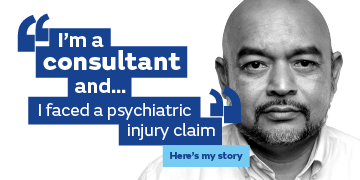The four principles of medical ethics
Post date: 08/02/2024 | Time to read article: 6 minsThe information within this article was correct at the time of publishing. Last updated 08/05/2024
Medical Protection explores the unique interplay between justice, patient autonomy and the law, as well as outlining the essential four principles of ethics.
Medical practice is frequently an ethical and legal minefield. So what helps us manage these dilemmas in an effective way? The answer is – rarely, the law, but commonly, ethics.
Here is our short introduction to ethics, the four principles of practice, and medical justice.
Law vs ethics
First penned around 400BC, the Hippocratic Oath sounds a bit old-fashioned today. However, there are common threads in the text that new doctors and healthcare workers may find useful use as guiding principles.
"Medical practice is an ethical and legal minefield. So what helps us manage these dilemmas in an effective way? The answer is – rarely, the law, but commonly, ethics"
In more recent times, statute (parliament-made) and common (court-made) law has piled many layers of formal legal duties on doctors, but the law has largely reflected long-standing ethical principles. Judges and politicians drive our behaviour at the periphery, but our collective ethical consciences have historically had a much greater impact.
The content of those “collective ethical consciences” is reflected in documents, such as the GMC’s Good Medical Practice. It begins: “Good Medical Practice sets out the principles and values on which good practice is founded; these principles together describe medical professionalism in action.”
To put it simply, ethics drive our behaviour, not the law; whereas the law largely reflects ethics.
The four principles (or principles) of medical ethics are defined as:
- Autonomy – respect for the patient’s right to self-determination
- Beneficence – the duty to ‘do good’
- Non-Maleficence – the duty to ‘not do bad’
- Justice – to treat all people equally and equitably.
The law reflects these principles as follows:
Autonomy:
- Consent
- Confidentiality/Privacy
- Access to Records
Beneficence:
- Negligence Law
Non-Maleficence
- Criminal Law
- Negligence Law Regulation
Justice
- Anti-discrimination law
Medical paternalism
There is little in the Hippocratic Oath about the patient’s right to make their own healthcare decisions or their right to be fully informed and involved. Medical paternalism was the accepted standard of medical practice for centuries. In 1871, in an address delivered to the graduating class of the Bellevue Hospital Medical College, Oliver Wendell Holmes, said: “Your patient has no more right to all the truth than he has to all the medicine in your saddle-bags... he should get only just so much as is good for him.”
"Doctors cannot ‘force’ patients to follow their advice, but equally, doctors can refuse to give treatment that they think is not in the patient’s best interest"
Over the course of the 20th century, the pendulum has swung away from this model of the doctor as a ‘benevolent despot’. It has not swung to the other extreme – a ‘servile technician’ model in which the doctor is a technician who does what the patient orders, but to a middle of the road position, characterised by ‘shared decision making’.
Doctors cannot ‘force’ patients to follow their advice, but equally, doctors can refuse to give treatment that they think is not in the patient’s best interests.
Autonomy
In 1914, Benjamin Cardozo, a judge in the New York Court of Appeals and later an Associate Justice of the Supreme Court, handed down a decision that formulated the principles underpinning the consent model for undertaking medical procedures.
The case was this – following an examination, Mrs Mary Schloendorff was thought to have uterine masses. She agreed to have an examination under anaesthesia to assess whether her uterine masses were fibroids or something more sinister.
She specifically withheld consent for any other procedure. However, upon further examination her gynaecologist found a malignant tumour and went ahead and performed a hysterectomy.
When Mrs Schloendorff awoke, she sued the gynaecologist who had performed the surgery. Justice Cardozo then found that the gynaecologist’s actions constituted medical battery. A phrase from his judgment states:
“Every human being of adult years and sound mind has a right to determine what shall be done with his own body…”
Justice Cardozo’s two caveats are – “adult years” and “sound mind”. The patient must be ‘competent’, that is above the legal age of consent, or below that age and judged to be intellectually and emotionally competent to make their own decision. The latter is known as ‘Gillick’ competence, after the case in which that principle was stated.
Autonomy includes a right to privacy, and hence a doctor’s duty to maintain confidentiality. Hippocrates wrote: “Whatever in connection with my professional practice or not in connection with it I may see or hear in the lives of my patients which ought not be spoken abroad, I will not divulge, reckoning that all such should be kept secret.”
But note the weasel clause, “which ought not be spoken abroad”. In Hippocrates’ time, as is the case now, there are times when a doctor’s duty to the community, and a general duty to prevent forseeable harm, over rides their duty of confidentiality to an individual patient.
"Autonomy includes a right to privacy, and hence a doctor’s duty to maintain confidentiality"
Beneficence/Non-Maleficence
In the consent case described above, Justice Cardozo added in his judgment: “A surgeon who performs an operation without his patient’s consent commits an assault for which he is liable in damages. This is true except in cases of emergency where the patient is unconscious and where it is necessary to operate before consent can be obtained.”
The last sentence states the principle of ‘Emergency Privilege’. Your first duty is to act in the best interests of your patients. If a patient is unconscious and there is no time to seek consent from an ‘alternative decision maker’, you have the right – and duty – to do whatever is necessary to protect the patient from harm. This is one aspect of Beneficence.
Beneficence: Acting in the best interest of the individual; providing benefit. Non-maleficence: Avoiding and doing no harm to the individual.
It goes much further than that. The Hippocratic Oath outlined beneficence and non-maleficence two millennia before Justice Cardozo. He said: “I will follow that method of treatment which according to my ability and judgment, I consider for the benefit of my patient and abstain from whatever is harmful or mischievous.”
In earlier times, legal actions brought against doctors who had harmed patients were either criminal cases or civil cases brought in contract rather than negligence. However, after an English non-medical judgment in 1932, the modern law of negligence was defined, and medical negligence claims started to materialise.
The Montgomery case
The most recent defining medical case in the history of consent went to judgment in 2015. Doctors must now ensure that patients are aware of any “material risks” involved in a proposed treatment, and of reasonable alternatives, following the judgment in the case Montgomery v Lanarkshire Health Board.
In 1999, Nadine Montgomery gave birth by vaginal delivery to Sam. The birth was complicated by shoulder dystocia. Medical staff performed the appropriate manoeuvres to release Sam but, during the 12-minute delay, he was deprived of oxygen and subsequently diagnosed with cerebral palsy.
Mrs Montgomery is diabetic and small in stature and the risk of shoulder dystocia was agreed to be 9-10%. Despite expressing concern to her consultant about whether she would be able to deliver her baby vaginally, the doctor failed to warn Mrs Montgomery of the risk of serious injury from shoulder dystocia or the possibility of an elective caesarean section.
Mrs Montgomery brought a claim against Lanarkshire Health Board, alleging that she should have been advised of the 9-10% risk of shoulder dystocia associated with vaginal delivery notwithstanding the risk of a grave outcome was small (less than 0.1% risk of cerebral palsy).
It was also alleged that delivery by caesarean section ought to have been offered to Mrs Montgomery, and that this would have prevented the child’s injury.
Lanarkshire Health Board argued that only the risk of a grave adverse outcome triggered the duty to warn of such risks and that, because the risk of such an outcome was so low and that an expression of concern was not the same as a direct question requiring a direct answer, no warning was required.
Judgment
The Supreme Court held that the question should have been about Mrs Montgomery’s likely reaction if told of the risk of shoulder dystocia. The unequivocal position was that she would have chosen to give birth by caesarean section.
The Bolam test was deemed unsuitable for cases regarding the discussion of risks with patients, as the extent to which a doctor may be inclined to discuss risks with patients is not determined by medical learning or experience.
The court ruled that Mrs Montgomery should have been informed of the risk of shoulder dystocia and given the option of a caesarean section.
Mrs Montgomery was awarded £5.25 million in damages.
Justice
There are three elements to Medical Justice:
- Distributive justice – fair distribution of limited healthcare resources
- Rights-based justice – respect for people’s rights, such as prohibition of discrimination
- Legal justice – respect for the law.
On an individual patient level, there are some obvious elements to ‘Justice’– for example, not discriminating against patients on the basis of their colour, race, religion, etc; but can we refuse to perform cardiac surgery on a patient because they smoke? Is that discrimination – punishing the patient for not stopping – or a fair medical judgment based on their increased risk of complications at and after surgery?
"On an individual patient level, there are some obvious elements to ‘Justice’– for example, not discriminating against patients on the basis of their colour, race, religion, etc; but can we refuse to perform cardiac surgery on a patient because they smoke?"
More broadly, we do our best to maintain a focus on the patient in front of us, but we are aware of the need to balance that patient’s rights and needs against the need for an equitable allocation of healthcare funds and resources. Who decides what is ‘equitable’? The ethical principle of Justice imposes a moral obligation to decide fairly between competing claims.
References
- Schloendorff v Society of New York Hospital (1914)
- Gillick v West Norfolk and Wisbech Area Health Authority (1985)
- Donoghue v Stevenson (1932)
What to do next
Medical Protection is committed to education and training. As well as helping you provide the best care for your patients, we want to support your development. That is why we have developed two online learning modules on the topics covered in this article, so that you can download a certificate of completion as evidence of your learning for your ePortfolio.
- Once you’ve read this article, simply go to our online learning page where you can register for the eLearning platform
- You’ll need your membership details to register and log on
- Once logged on, you will be able to access the modules highlighted on the home page
- You can complete the modules at a time that suits you
- Download your certificate of completion and any supporting notes
- Other modules on a wide range of subjects can also be accessed as part of your membership.
Further information
- Access the Medical Protection's library of factsheets, this includes detailed information on the law around consent and confidentiality.




